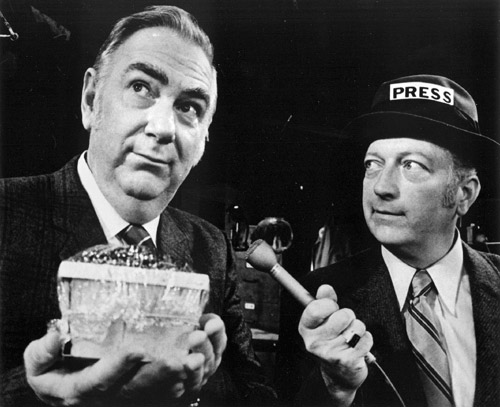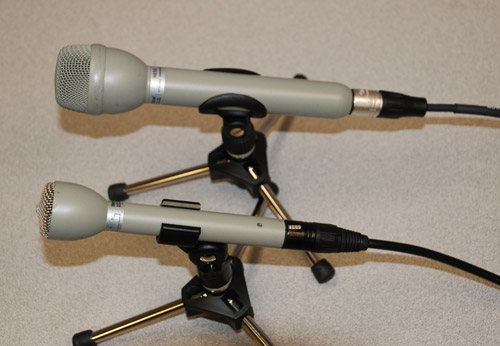Guest column by Peter Welander, Control Engineering process industries editor.
If you’re considering how you can get your podcast and video productions to the next level (to use a very tired phrase) one easy step that will get a lot of bang for the buck is improving your microphones. Here are two designed for field use that you should look at if you’re starting out.

Bob interviews Ray with a 635A.
These two are considered “industry standards” and have gathered wide acceptance thanks to a useful collection of features. Of course there are dozens of choices available in any given area, but the characteristics of these can help you evaluate others by comparison.

ElectroVoice RE50 and RE50B: This microphone is a standard for hand-held interviewing, and one if the most versatile tools you can buy. (The B designates black finish.) If you actually get geekish enough to start looking at the microphones you see on TV (I do) you’ll see them in all sorts of situations, including the Weather Channel where some poor sap is standing in a hurricane trying to describe what’s going on. Here’s why:
- Resists handling noise so it won’t pick up sound from your hands;
- Wind resistant so you can use it outdoors;
- Resists p-popping so you can get close to your subject in a noisy environment;
- Dynamic, so it needs no phantom power;
- Omnidirectional, so you don’t have to point it precisely; and
- It also works great in a stand for use on a table.
What’s more, it makes you look really professional if you’re doing video. That never hurts. It is a little big, but that’s not a bad thing in these situations.

The RE50 is an excellent choice for any face-to-face interviewing opportunity.
If you don’t want to spend so much money, they are available used. I have a couple from eBay. Older original RE50 units are a gray-green (EV calls it beige) which also looks good on camera. Nice black ones will go for $100.+ but older green ones sell for $50.-$70.
Other similar mics from other manufacturers include Shure VP64A and AKG D230, but these aren’t nearly as common on the used market.

While the 635A is smaller, it lacks the internal cushioning the larger RE50 uses to reduce handling noise.

ElectroVoice 635A: Another workhorse, nicknamed the “Buchanan Hammer” for its indestructibility. (The legend goes that an ElectroVoice salesman used to demonstrate its durability by driving nails with it. Given that the company was located in Buchanan, MI, the name stuck.) It has many of the same attributes of an RE50, but to a lesser extent:
- OK for hand holding, but not as good as an RE50;
- Somewhat wind resistant so you can use it outdoors if not too breezy;
- Resists p-popping so you can get close to your subject in a noisy environment;
- Dynamic, so it needs no phantom power;
- Omnidirectional, so you don’t have to point it precisely;
- It also works great in a stand for use on a table; and
- They are not fragile, so you can toss them in a bag.
The 635A is smaller than an RE50, but isn’t as good for hand-held use. If you’re doing interviews across a table with multiple mics on stands, they’re fine.
This model has been in production for decades. It was considered a classic when I was in college in the 1970’s, and there must be many thousands in circulation. You can find used ones around in every conceivable condition. Beaters sell on eBay for $40 and less. Really nice ones for $75.-$85. I probably wouldn’t buy one that looks really clobbered, but ugly can still work amazingly well. Some of them can be 40 years old.
Another similar mic from a different manufacturer is the Audio-Technica AT804, but there aren’t as many of these around.
Put these broadcaster’s tools to work to improve your podcast and video productions.
